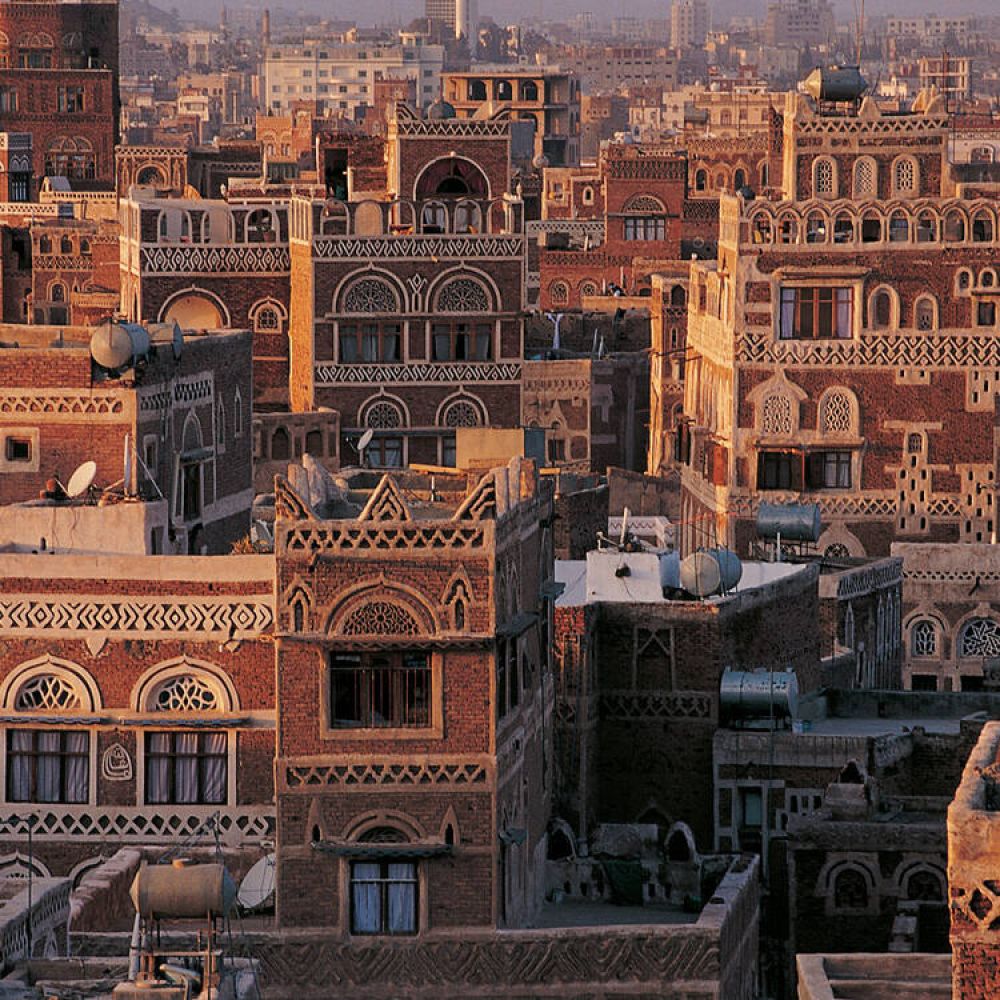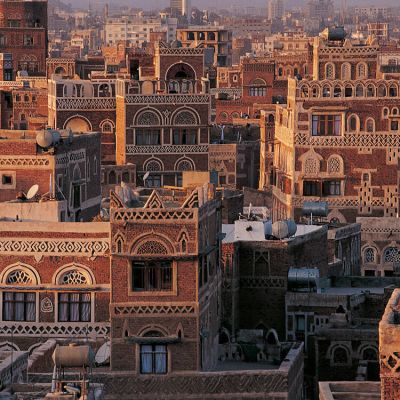

Bab al-Yemen, or the Gate of Yemen, is an iconic entry point to the Old City of Sana'a, offering visitors a genuine glimpse into ancient Yemeni culture and architecture. With its massive, fort-like appearance, the gate has stood as a guardian of the city since as early as the 7th century. Venturing through this historic portal, you'll find yourself immersed in a bustling market selling everything from spices to traditional fabrics. The vibrant atmosphere is reminiscent of a time long past, with the scent of incense and the sound of local dialects filling the air. The gate itself is a testament to the artistry and engineering of the Yemeni people, whose detailed stone carvings and robust construction have survived through the ages. As foreigners, take some time to absorb the historical significance of this ancient gateway and its surroundings, reflecting the city's role as a crucial trading center over millenniums.
The Great Mosque of Sana'a, also known as Al-Jami' al-Kabir, is one of the oldest and most significant mosques in the Islamic world, with a foundation dating back to the Prophet Muhammad's era. Offering an insightful experience into the city's religious heritage, this architectural masterpiece features ancient Islamic designs and traditional Yemeni construction techniques. The mosque stands as a silent witness to centuries of devotion and culture, with its beautiful minarets towering over the city's skyline. Visitors can admire the exquisite calligraphy and detailed ornamentation that adorn its walls, reflecting the artistry of the region's skilled craftsmen. Non-Muslim visitors may need to appreciate the exterior as entry may be restricted, but the facade alone provides a unique window into Yemen's deep-rooted Islamic traditions. Exploring the mosque's surroundings can take you on a journey through time, connecting you to the spiritual life of the Old City of Sana'a.
Souk al-Milh is a bustling marketplace located at the heart of the Old City of Sana'a, and it's where history comes alive through the sights, sounds, and smells. The 'Salt Market' is more than just a place for commerce; it is a cultural tapestry that has been interweaving threads of local customs for centuries. As you navigate through the dense alleys, you are greeted by vivid displays of spices, grains, and the namesake salt, as well as traditional Yemeni crafts and textiles. The rhythmic bargaining between buyers and sellers, the aroma of fresh produce and the striking colors of exotic goods create an unforgettable sensory experience. The souk also offers a chance to witness artisans at work, demonstrating age-old techniques in metalwork, jewelry making, and other crafts. Spending time in the market gives you an authentic taste of daily life in Sana'a, and it is an opportunity to connect with the local community and perhaps acquire unique souvenirs.
The House of Folklore in Sana'a provides visitors with an immersive experience into Yemeni culture and history. It is a museum that captures the essence of traditional life in Yemen, displaying a range of exhibits from customary attire to musical instruments. The House of Folklore serves as a treasure trove of information, showcasing the diverse customs, oral histories, and artistic heritage of the Yemeni people. As you wander through the rooms, you'll come across colorful tapestries, historic photographs, and other artifacts that speak volumes about Yemen's rich cultural tapestry. The local guides are knowledgeable and eager to share stories that breathe life into the displays, enhancing your understanding of why Sana'a is such a celebrated UNESCO World Heritage site. Visiting this museum offers a unique opportunity to delve deep into the social and cultural dynamics that have shaped the lives of Yemenis over the centuries.
The multi-storied houses of Sana'a's Old City are an architectural marvel and a key highlight of any visit to the area. These storied towers, built of rammed earth and burnt brick, feature unique geometric patterns and intricately decorated white gypsum windows. With foundations that sometimes date back over a thousand years, these buildings offer a living history of architectural evolution and adaptation. Visitors can roam the narrow streets and alleyways to fully appreciate the craftsmanship and genius of ancient Yemeni builders. Besides their distinct beauty, these houses are also engineered to cope with the local climate, providing insight into early sustainable building practices. While individual access to these residences may be limited as they are still inhabited, their collective grandeur creates a historical landscape unique to Sana'a, and it's what makes the skyline an unforgettable silhouette against the Yemeni sky.
Although not within the confines of the Old City, the iconic Dar al-Hajar (Rock Palace) makes for an exceptional half-day excursion from Sana'a. Perched atop a towering rock pinnacle about 15 kilometers outside the city, this former royal palace, built in the 1930s, is a symbol of Yemeni ingenuity. A visit here allows you to explore the intricately-designed interiors and to climb up to the rooftop for panoramic views of the surrounding Wadi Dhahr valley. The striking image of Dar al-Hajar, often depicted in postcards and travel books, is emblematic of Yemen's aesthetic harmony between natural landscapes and human craftsmanship. Beyond its surreal appearance, the palace is also rich with modern history, offering insights into the lives of former rulers and their dynasties. It's a must-see destination that complements the cultural narrative found in Sana'a's historical heart.
Located in Sana'a, the National Museum is an essential stop for history buffs interested in learning about Yemen's intricate past. Housed in a former royal palace, the museum boasts a collection that spans the rich tapestry of Yemeni history from the pre-Islamic kingdoms of Saba and Himyar to the modern day. The museum's exhibits include ancient Sabaean inscriptions, magnificent statues, and artifacts recovered from the UNESCO-listed Marib Dam. Visitors will be intrigued by the Islamic art section, which includes rare manuscripts and local crafts. Furthermore, the museum provides a comprehensive overview of the traditional costumes and jewelry representing the various regions of Yemen. While reflecting on the various exhibits, you gain a deeper understanding of the forces that have shaped the country's history and identity. Be sure to check ahead for opening times, as they can vary, and be mindful of potential closures due to the ongoing conflict in the country.
The majestic Al-Saleh Mosque, a relatively new addition to Sana'a completed in 2008, stands as a symbol of contemporary religious architecture juxtaposing the ancient silhouette of the Old City. However, visitors across all beliefs are welcomed to explore the mosque's beautifully maintained gardens. The landscape surrounding this grand mosque is a testament to the peace and tranquility that green spaces can offer amidst an urban setting. With its elaborate fountains and well-groomed flora, the gardens provide a serene escape where one can pause and reflect. Here, the local community comes together, offering a chance to engage with residents in a setting that respects cultural and spiritual values. Please note that while the mosque interior is generally reserved for worshippers, the exterior grounds offer a respectful and inviting atmosphere for all visitors.
The Old City of Sana'a, with its distinctive architectural wonders, presents an excellent opportunity for a photography tour. Capture the essence of Sana'a's historical streets, from the ornately decorated windows and doors to the bustling market life within. Photography enthusiasts and professionals alike will find the play of light and shadow upon the ancient buildings to create a challenging yet rewarding subject. Numerous vantage points throughout the city offer panoramic views for sprawling cityscapes, creating breathtaking images during sunrise and sunset. When interacting with local merchants and residents, always ask for permission before taking photos to respect their privacy and customs. Those who appreciate the delicate balance of human activity within such a storied environment will find no shortage of captivating scenes to immortalize in their travel portfolios.
For a taste of authentic Yemeni culture, there is nothing quite like attending a local cooking class. Learn how to create traditional dishes such as Saltah, a meat-based stew, or Bint al-Sahn, a sweet honey cake that's a favorite during Ramadan. Cooking classes usually include a visit to the market to pick fresh ingredients, followed by a hands-on session led by a local chef or home cook. Such classes are more than just a culinary lesson; they are a cultural exchange that offers insight into daily life, family traditions, and regional flavors. Participants can look forward to ending the class by savoring their own-cooked meal, connecting the spices and techniques learned with the rich tastes that characterize Yemeni cuisine.
